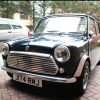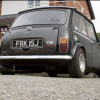
What Sort Of Speed Should I Be Getting?
#46

Posted 14 April 2014 - 06:13 AM
#47

Posted 14 April 2014 - 06:19 AM
In answer to the OPs question, it is worth making sure the brakes aren't sticking on, the engine is well serviced, and set up.
It may be worth a stage 1 kit and a rolling road session.
Its also worth checking the exhaust for leaks as this will make the car louder and make you less inclined to rev it
Haven't visually checked the brakes but have had to push it a lot recently and there doesn't seem to be any resistance
Exhaust has just been refitted and all seems ok
Genuinely think I just need to put my foot don't and stop worrying about the noise. Pretty sure it's engine rather than exhaust
#48

Posted 14 April 2014 - 06:20 AM
OP, when you tell us what RPM you're doing at your given speeds, tell us your tyre size too please. Ta
12x5 wheels
#49

Posted 14 April 2014 - 08:51 AM
He needs the tyre size really, likely to be 165/60/12 but there are other possibilities.
#50

Posted 14 April 2014 - 08:52 AM
#51

Posted 14 April 2014 - 09:17 AM
Matt, I reckon I was just doing a good job of confusing myself. All the rights facts but the wrong conclusion.
I'm quite happy that to increase the speed by a factor you increase both the amount (mass) of air and its acceleration by the same factor, which means that factor is squared to rebalance that f=ma equation. Extrapolating from force to engine power is a matter of the gearing.
Still got some more head scratching or reading to do over thrust though - airplane on a conveyor belt runway?
#52

Posted 14 April 2014 - 10:52 PM
Tamworthbay, the only reason that I even attempted to swap the diff in situ was because I knew that certain early rally teams had done it, so it must be possible. In all fairness, many people here will tell you that it will be quicker to lift the engine, and that may or may not be true, certainly the time saving is not great. But I didn't have an engine crane at the time, so lifting the engine would have involved splitting it in situ, which I have been known to do, not recommended.
Anyway, roughly speaking, what I did was drain oil, exhaust unbolted, top and bottom steadies disconnected, radiator out, radiator end engine mount off, with gearbox supported by trolley jack. Shell supported by length of 4x2 across floor/toeboard joint on two axle stands. Bottom ball joints undone, pots pulled out of diff. Gearchange rod off.
Gearbox end extension case off, I think there is an adaptor block that comes off first to get access to all the bolts. Something hard wedged between FD gears, which were going to be replaced. Pinion nut undone. Diff side covers off and casing unbolted (possibly clutch end engine mount off, and engine pushed forwards to get extra clearance, but I don't remember having to). May have to use double nuts to extract the studs, to get clearance to get the casing off, but I seem to remember that mine had bolts). Diff then comes out easily. Gear removed from diff on bench, and new gear fitted.
Diff assembled into case with new gaskets etc, and shimmed using normal procedure. Pinion nut tightened by engaging suitable gear, can't remember if it was first or reverse, but will be obvious. Socket on pinion nut, and torque wrench. Second socket, or actually a ring spanner, on crankshaft nut, and this is where the choice of gear matters, because crankshaft must be rotating clockwise to get pinion nut to tighten, so neither is being loosened.
After that, reassembly is straightforward, and I was changing the pair of gears. I would never do otherwise.
Was it worth it, and would I do it that way again? Not sure, and I now have an engine crane, but the car ran very well for maybe 70k miles after that, with no diff or transmission problems.
As for City E performance, and lack of torque, I am puzzled by some remarks, and suspect that mine may have been one of the better ones, because there was sufficient torque for all normal circumstances, which did actually surprise me. But I do remember seeing the carburettor for the first time, large for a 998, and the compression has unusually high, hence the frequent running on, and rapid failure of the recommended Bosch spark plugs (never used a Bosch since, Champion were fine, and so was one of the Japanese brands, can't remember which). I did keep the timing and valve clearances properly adjusted, but not any more accurately than will be normal nowadays.
My usage involved frequent fast runs up the M1/M6/A74 and a few steep gradients (Canonbie Road in South London was one which needed second gear, but it accelerated up it in second).
1 user(s) are reading this topic
0 members, 1 guests, 0 anonymous users














